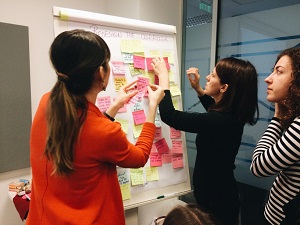When we first visited schools in spring 2016 for this project–a multi-year, multi-method study of systemic efforts to support schools implementing personalized learning—teachers seemed to be taking on an unsustainably heavy lift as they transitioned to personalizing student learning (PL). Teachers were often rewriting units and lessons from scratch, with the added expectation that these aligned with a diverse range of student interests, learning styles, and needs. (Oh, and please align them to new Common Core standards while you’re at it!) We saw teachers shouldering this Herculean task while still uncertain about what PL meant and what it should look like in the classroom. In other words, they were shooting at a moving target.

This clear recipe for burnout was top of mind for many principals we interviewed back then, and it remains a concern now.
But returning to these same schools this fall, we were encouraged to see new system-level initiatives surfacing for teachers to network and support each other in the effort to radically remake the classroom. Initiatives in a Colorado district and New Orleans in particular stand out.
In one Colorado district, middle and high school teachers collaborate with their subject peers districtwide to write “common units.” These teachers not only draft unit plans together but also follow up to discuss implementation, review student work, and revise the plan for the next year. The unit I observed offered students rich content plus interesting and complex assignments and projects from which students could map their learning. When I talked with the teacher after class, he described the collaborative unit development process as deeply professional and engaging. This struck me as a triple win: the students had a high-quality learning experience, the teacher had a rewarding professional experience, and the burden of creating the unit was shared among a group of teachers rather than each teacher laboring in isolation.
New Orleans launched a PL-focused teacher network founded by two educators and supported by New Schools for New Orleans (NSNO), a regional partner. The network aims to help a small cadre of teachers help each other successfully integrate select PL components in their own classrooms with the goal of amplifying those teachers’ learning schoolwide and, ultimately, citywide. NSNO established a framework of basic PL principles to help create common language and understanding across teachers and principals in the nation’s most decentralized school system. Roughly 20 teacher fellows in the network commit to integrating some element of the PL framework into their own practice. For example, one teacher might choose to develop a model for using Google Suite to enhance collaboration and student autonomy. The teacher fellows serve as peer consultants, regularly visiting each other’s classrooms and giving structured feedback on what they see. The goal is for fellows to develop made-in-New-Orleans strategies around their chosen PL project so that these strategies can be a model for other New Orleans teachers and schools. To start the dissemination process, fellows present efforts at an end-of-year showcase.
Though different in approach and focus, the Colorado and New Orleans initiatives share a few features that strike us as valuable to teachers’ experience.
First, although they operate across schools and suggest system-level responses, the initiatives are educator-led. Second, the networks have enough facilitation to leverage the knowledge teachers do have while providing them with support from consultants or technical assistance providers to advance their collective learning. With this support, teachers feel less like the blind leading the blind. Third, these initiatives have some hallmarks of solid professional learning, like giving opportunities for practice with feedback and treating adult learning as a shared experience or “joint work.”
We’ll be watching these efforts unfold to learn more about their influence on teacher practice. In the meantime, district leaders and regional partners looking to grow PL in their district or region would be well-served to create system-level networks that encourage and leverage teacher leadership from different schools to help reinvent their classrooms together. There really is no need for teachers to go it alone.
— Betheny Gross
Betheny Gross is senior analyst and research director at the Center on Reinventing Public Education at the University of Washington Bothell.
This post originally appeared on CRPE’s The Lens and is the eighth installment in their “Notes From the Field” series.


